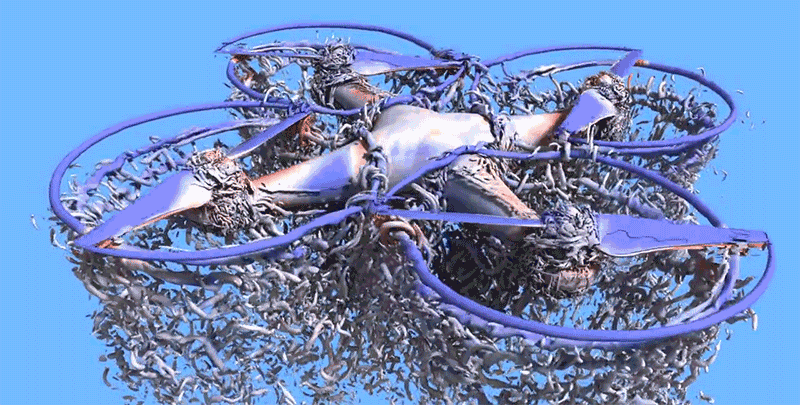January 18, 2017

For decades, NASA has used computer models to simulate the flow of air around aircraft in order to test designs and improve the performance of next-generation vehicles.
At NASA’s Ames Research Center in California’s Silicon Valley, researchers recently used this technique to explore the aerodynamics of a popular example of a small, battery-powered drone, a modified DJI Phantom 3 quadcopter.
The Phantom relies on four whirring rotors to generate enough thrust to lift it and any payload it’s carrying off the ground. Simulations revealed the complex motions of air due to interactions between the vehicle’s rotors and X-shaped frame during flight.
As an experiment, researchers added four more rotors to the vehicle to study the effect on the quadcopter’s performance. This configuration produced a nearly twofold increase in the amount of thrust.
The findings offer new insights into the design of autonomous, heavy-lift, multirotor vehicles for uses such as cargo transportation.
This research was presented at the 2017 American Institute of Aeronautics and Astronautics SciTech Forum in Grapevine, Texas, by Seokkwan Yoon of the NASA Advanced Supercomputing Division at Ames.
Source: NASA

For decades, NASA has used computer models to simulate the flow of air around aircraft in order to test designs and improve the performance of next-generation vehicles.
At NASA’s Ames Research Center in California’s Silicon Valley, researchers recently used this technique to explore the aerodynamics of a popular example of a small, battery-powered drone, a modified DJI Phantom 3 quadcopter.
The Phantom relies on four whirring rotors to generate enough thrust to lift it and any payload it’s carrying off the ground. Simulations revealed the complex motions of air due to interactions between the vehicle’s rotors and X-shaped frame during flight.
As an experiment, researchers added four more rotors to the vehicle to study the effect on the quadcopter’s performance. This configuration produced a nearly twofold increase in the amount of thrust.
The findings offer new insights into the design of autonomous, heavy-lift, multirotor vehicles for uses such as cargo transportation.
This research was presented at the 2017 American Institute of Aeronautics and Astronautics SciTech Forum in Grapevine, Texas, by Seokkwan Yoon of the NASA Advanced Supercomputing Division at Ames.
Source: NASA
Read more at:
http://www.uasvision.com/2017/01/18/nasa-explores-drone-aerodynamics/
This comment has been removed by the author.
ReplyDeletenice post
ReplyDeleteSo well discover by NASA and i think it will be so more effective invention for drone technology. quadcopters for sale give us more information about this education in here. I hope every one are like this education in here.
ReplyDeleteI personally use them exclusively high-quality elements : you will notice these folks during: Drone Parts
ReplyDelete